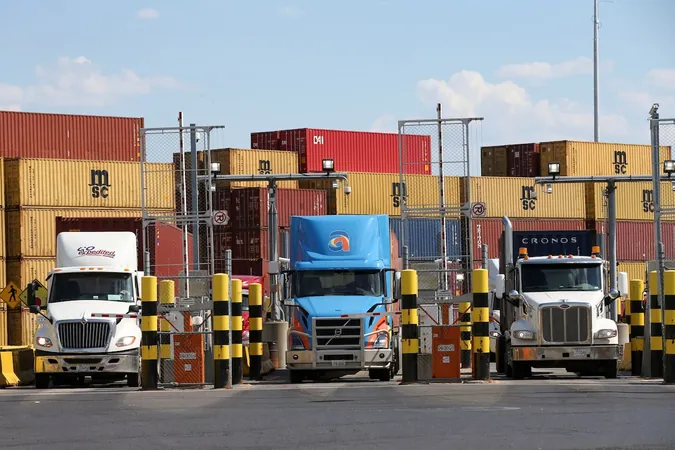
Canadian Exports Experience Growth Amid Political Tensions with U.S.
2025-01-07
Author: Charlotte
Canadian Exports Experience Growth Amid Political Tensions with U.S.
In a revealing economic snapshot for November, Canada recorded its ninth consecutive trade deficit, yet simultaneously saw a noteworthy increase in its trade surplus with the United States. This trend not only highlights Canada's economic resilience but also raises important political implications as Donald Trump prepares to take office for a second term.
Overall, Canada's merchandise trade exports climbed by 2.2% in November, while imports rose by 1.8%. This shift effectively narrowed the trade deficit with the rest of the world to $323 million, a significant improvement compared to the revised figure of $544 million from the previous month.
Crucially, the trade surplus with the U.S. surged to $8.2 billion, up from $6.6 billion in October, driven by a robust 6.8% increase in exports to the U.S., alongside a 4.1% uptick in imports from its southern neighbor. While this monthly surplus is relatively modest compared to historical averages, it gains amplified political significance in light of Trump's past criticisms of U.S. trade deficits and his aggressive tariff threats.
The president-elect has made no secret of his intention to impose 25% tariffs on Canadian imports unless Canada addresses specific border security issues. Recently, he took to social media to declare, 'The United States can no longer suffer the massive Trade Deficits and Subsidies that Canada needs to stay afloat. Justin Trudeau knew this, and resigned.' He further suggested a union between the two nations, claiming it would eliminate tariffs and lower taxes.
Canada's economy has become increasingly dependent on access to the U.S. market, which absorbs approximately 75% of its exports. Experts warn that severe tariffs could plunge Canada into a recession, severely curtailing business investments. Toronto-Dominion Bank economist Marc Ercolao noted that while it’s hoped that Canada can largely dodge the full brunt of Trump’s tariff plans due to their energy-dominated trade relations, even minor tariffs could have detrimental effects on economic growth.
The increase in Canadian exports was broad in scope; metals and nonmetallic ores surged by 10.5%, industrial machinery and parts rose by 3.8%, and aircraft and transportation equipment grew by 6.7%. Energy exports, particularly crude oil, also benefited, with an increase of 2.2% and a notable 4.8% rise in oil prices.
However, the automotive sector saw exports dip by 1.2%, putting pressure on an already struggling industry. On a broader scale, the weakness of the Canadian dollar against its U.S. counterpart has bolstered Canadian exports, rendering them more attractive to American consumers.
In a potential anticipatory response to looming tariff threats, Canadian companies are increasingly moving goods across the border. A December survey found that about one-third of over 300 responding firms were accelerating shipments to the U.S., hinting at strategic beats made in an uncertain landscape.
The volume of total exports grew by 0.5% in November, marking the third consecutive monthly rise and suggesting economic momentum was building at the close of the year. Yet, experts caution that any forthcoming U.S. tariffs could derail this recovery, even as they may spur near-term support as businesses rush to export before potential cost hikes.
Meanwhile, Canada saw merchandise exports to non-U.S. countries plummet by 10.3%, largely due to declines in gold shipments to Hong Kong and nickel exports to Norway. The trade deficit with regions outside the U.S. widened from $7.2 billion to $8.5 billion in November.
In parallel, service exports fell by 0.2%, leaving the services trade deficit relatively unchanged at about $300 million. The unfolding dynamics of Canadian trade reveal not just economic statistics, but a narrative woven with political tension and the pressing uncertainties in international relations. As Trump's inauguration approaches, all eyes will remain on how these developments may reshape trade policies affecting both nations.



 Brasil (PT)
Brasil (PT)
 Canada (EN)
Canada (EN)
 Chile (ES)
Chile (ES)
 Česko (CS)
Česko (CS)
 대한민국 (KO)
대한민국 (KO)
 España (ES)
España (ES)
 France (FR)
France (FR)
 Hong Kong (EN)
Hong Kong (EN)
 Italia (IT)
Italia (IT)
 日本 (JA)
日本 (JA)
 Magyarország (HU)
Magyarország (HU)
 Norge (NO)
Norge (NO)
 Polska (PL)
Polska (PL)
 Schweiz (DE)
Schweiz (DE)
 Singapore (EN)
Singapore (EN)
 Sverige (SV)
Sverige (SV)
 Suomi (FI)
Suomi (FI)
 Türkiye (TR)
Türkiye (TR)
 الإمارات العربية المتحدة (AR)
الإمارات العربية المتحدة (AR)